![]()
![]()
![]()
Use LEFT and RIGHT arrow keys to navigate between flashcards;
Use UP and DOWN arrow keys to flip the card;
H to show hint;
A reads text to speech;
16 Cards in this Set
- Front
- Back
- 3rd side (hint)
|
Rule5 - Lookout |
INTERNATIONAL//INLAND Every vessel shall at all times maintain a proper lookout by sight and hearing as well as by all available means appropriate in the prevailing circumstances and conditions so as to make a full appraisal of the situation and of the risk of collision. |
|
|
|
Rule5 - Lookout Tools (9) |
-sight and hearing -Binoculars -Radar -VHF radio -Automated radar plotting aids (sometimes called collision avoidance radar) -Differential GPS (DGPS) satellite navigation equipment -Automatic Identification Systems (AIS) radio transponders -Vessel traffic services -Navigation and piloting instruments |
|
|
|
Rule5 - Lookout Facts |
-responsibility rests with vessel operator -Purpose: to collect the information needed to avoid collisions. -determines if anchor is dragging, warn others -as visibility decreases, effort increases - vhf, radar, hearing, etc |
|
|
|
Rule 12(a)(i) Sailing vessels with the wind on different sides (starboard / port), Rule 12(a)(i) |
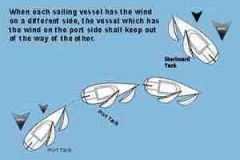
when each vessel has the wind on a different side, the vessel which has the wind on the port side must keep out of the way of the other;
|
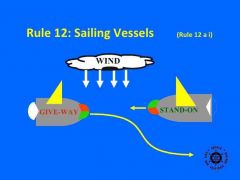
|
|
|
Sailing vessels with the wind on same side (leeward / windward), Rule 12(a)(ii) |
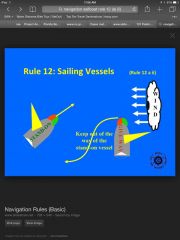
when both have the wind on the same side, the vessel which is to windward must keep out of the way of the vessel which is to leeward. |
|
|
|
Sailing vessel on port tack cannot determine windward sailing vessel's tack, Rule 12(a)(iii) |
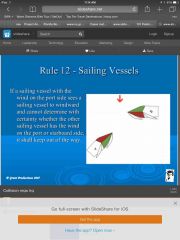
|
|
|
|
Overtaking (Rule 13) |
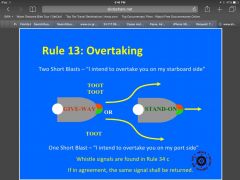
|
|
|
|
Power-driven vessels approaching each other head-on (Rule 14) |
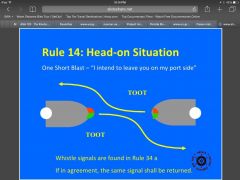
|
|
|
|
Power-driven vessel with another power-driven vessel on starboard side (Rule 15) |

|
|
|
|
Describe appropriate actions to be taken when sailing in the vicinity of commercial traffic, including responding to a danger signal. |
5 short blasts indicate danger. Stay out of the way.
Stay out of the way of commercial traffic. |
|
|
|
Give way vessel |
When a boat is directed to stay out of the way of another vessel, it is termed the give-way vessel. -take all necessary action to avoid colliding with the other vessel. -early and substantial or the other vessel may not clearly see your course change |
|
|
|
Stand on vessel |
When one boat is directed to keep out of the way of another, the other boat is termed the stand-on vessel.
-maintain course and speed
-may alter course if it becomes apparent that the give-way vessel is not following the established rules and a risk of collision is imminent. |
|
|
|
Summary of give way |
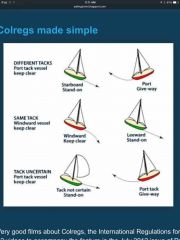
Back (Definition) |
|
|
|
Basic sound signals (3) You are action taking boat: - sound when leaving other boat on port - sound when leaving other boat on starboard - sound when backing up |

Back (Definition) |
|
|
|
Rule 34 sound signal - danger |
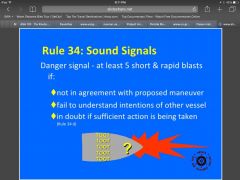
Back (Definition) |
|
|
|
When is a prolonged blast used? (3) |
Back (Definition) |
|

